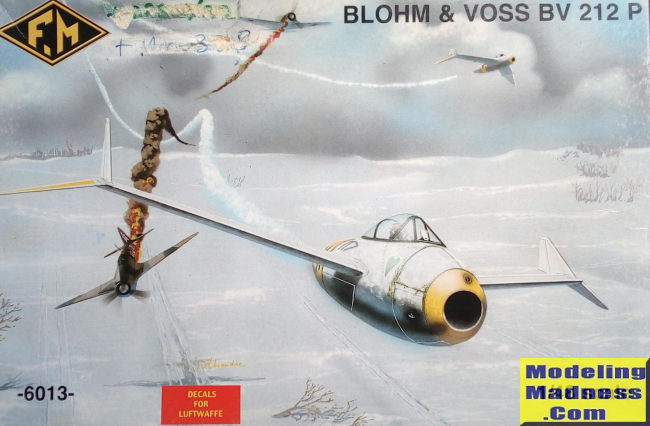
| KIT #: | 6013 |
| PRICE: | €35.00 |
| DECALS: | Two options |
| REVIEWER: | Spiros Pendedekas |
| NOTES: |

| HISTORY |
The Blohm & Voss P 212
was a proposed jet fighter designed by Blohm & Voss during the Second World War.
Its design studies could be traced in early 1945, when RLM sought a replacement
for the Heinkel He 162 Volksjäger under the continuing Emergency Fighter Program
(Jägernotprogramm). The new aircraft would be built around the new Heinkel HeS
011 jet engine that was in the developmental stage, in order to create a better
high-altitude fighter jet.
Blohm & Voss' proposal consisted of a tailless swept wing design with two small
vertical fins located near the wingtips. Its short, stubby fuselage would
contain the HeS 011 engine that would be air-fed by a front mounted intake. The
cockpit would be pressurized, whereas the wings design would allow them to be
made out of either wood, steel or aluminum as available. With an internally
carried fuel of 2100lt and another 600lt in two underwing drop tanks, an
endurance of four hours was envisaged.
Although the Ta 183 was finally chosen for production, three BV-212P prototypes
were ordered. Construction began in May 1945 and was terminated by the end of
the war, without any test flights being performed.
| THE KIT |
 Fonderie
Miniature released this kit back in 2001. It comes in a top opening box, with a
very attractive what-if box art of two ”Grünherz” BV-212Ps having just downed an
equal number of Russian piston fighters (which, interestingly, look like Fw-190
derivatives…).
Fonderie
Miniature released this kit back in 2001. It comes in a top opening box, with a
very attractive what-if box art of two ”Grünherz” BV-212Ps having just downed an
equal number of Russian piston fighters (which, interestingly, look like Fw-190
derivatives…).
Inside the box you are greeted with everything a modeler would expect of a
(very) limited run kit twenty years ago: first, there are two low pressure
injected gray sprues that contain most of the parts, sans the “detail” ones
(namely cockpit and landing gear parts). At those 38 injected parts you can
witness good amounts of flash, thick sprue gates and pebbly surfaces, together
with some signs of mold release agent. Detail is engraved and towards the soft
side.
The cockpit tub is an absolutely beautiful resin piece, very detailed and
precisely molded. All it needs is the addition of seat belts. Landing gear
parts, stick and rudder pedals are provided in white metal. Two very nice
looking vacform canopies are also provided.
Instructions want you to first assemble the main inner wings, followed by
cockpit, MLG bays and exhaust assembly. The fuselage halves then have to be
joined, with the cockpit, bays and exhaust trapped in between and the nose
attached to the front. Next, the complete wings have to be assembled and then
attached onto the fuselage, finishing with the landing gear assembly and
installation.
 Regarding the
instructions themselves, though they do contain all assembly info needed,
together with side and cutaway views, they are on the minimalistic side,
requiring careful study, in order for the modeler to obtain a clear view of what
goes where. No internal color callouts are given, with a "safe" choice being to
use late war Luftwaffe shades.
Regarding the
instructions themselves, though they do contain all assembly info needed,
together with side and cutaway views, they are on the minimalistic side,
requiring careful study, in order for the modeler to obtain a clear view of what
goes where. No internal color callouts are given, with a "safe" choice being to
use late war Luftwaffe shades.
Two what-if schemes are provided, for a JG26 and a JG54 bird. Of course, since
this is a what-if project, you can let your modeling imagination go wild and
come up with your "own"scheme. A small, well registered decal sheet contains
crosses, swastikas, white “2” codes and the de rigeur (?) ”Grünherz” green
hearts!
| CONCLUSIONS |
This is definitely a
challenging kit, proudly deserving the “ultra-limited run” attribution! The
injected parts require a lot of preparation/cleaning/sanding before assembly,
fit is expected to be demanding (“test fit 5 times before gluing once”), with
the extra effort required to deal with resin, white metal and vacform parts.
On the other hand, the small size of the model and the not too many parts, might
prove helpful in putting it together, let alone the fact that, since this is a "whatiffer",
you might at places “improvize” on parts to your liking or comforting (eg, use
modified leftover styrene landing gear parts from other kits: who will prove you
wrong?). With all the above said, I dare say that construction might not be too
challenging.
A number of modelers will run away by even hearing the name “Fonderie
Miniature”. Truth is that these kits are neither amongst the most refined or
easiest to put together, however all ingredients needed to provide a detailed
result are there. Fonderie Miniature provides subjects that are highly unlikely
to be seen by more mainstream manufacturers, this one being no exception (Just
Fantasy has issued a pure resin model of the same plane in 1/48, which our
Editor built back in 2001, coming with a really beautiful result out
of this very challenging kit).
I confess, I love this kind of kits and cannot wait to clear some bench space,
in order to give it a go and actually finish it: who knows, maybe I can come up
with a nice “alternate story” as well!
Happy modeling!
November 2021 Copyright
ModelingMadness.com. All rights reserved. No reproduction in part or in whole
without express permission. If you would like your product reviewed fairly and fairly quickly, please
contact
the editor or see other details in the
Note to
Contributors.